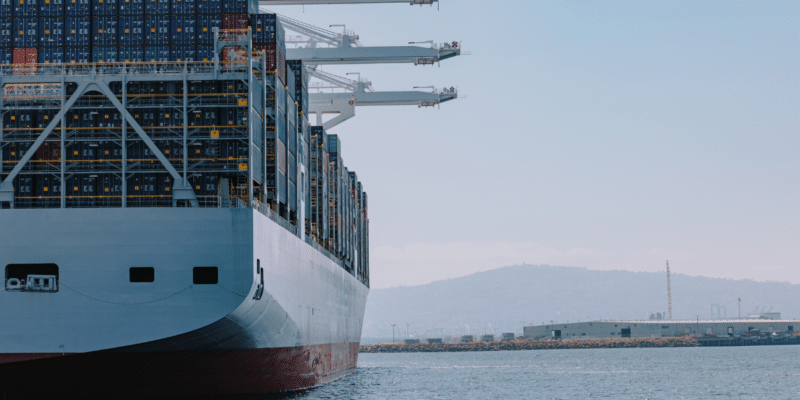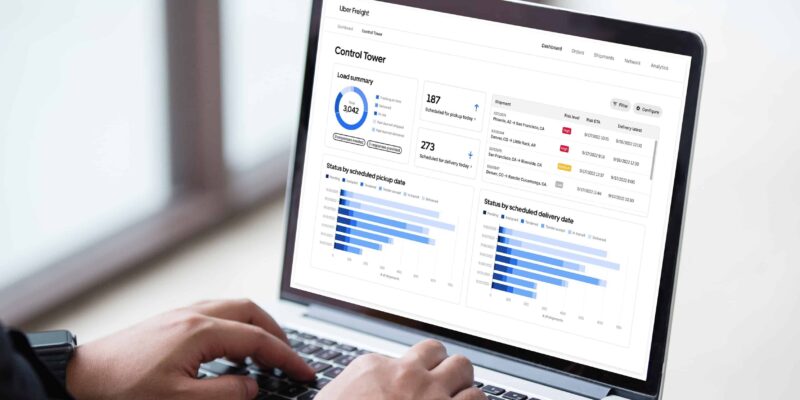
Here’s how a TMS can help you ship faster and smarter
The modern supply chain is embracing innovation at a rapid pace. Just a decade ago, real-time freight tracking was still in its infancy. GPS and RFID tagging systems already existed but few thought to use them for monitoring shipments. Carriers relied on phone calls to verify shipment details and schedule appointments. To compile reports, we had to sift through an endless pile of miscellaneous spreadsheets—a headache-inducing task that ended up taking way too much time and effort. But we’ve come a long way.
Fast forward to 2023, customer expectations are higher than ever. Businesses are competing to provide the best service and fastest delivery times in an effort to keep pace with demand. Automation of vital workflows, like demand forecasting and route optimization, are empowering leaders to execute shipments faster, smarter, and bolder.
Gaining a competitive edge in this evolving market requires 360-degree visibility. We have to think five, ten, twenty steps ahead in an effort to predict the unpredictable—and integrating a custom transportation management system (TMS) is an essential first step to replacing outdated workflows with cutting-edge technology.
A TMS empowers businesses by:
- Expanding carrier capacity
- Applying data-driven logistics planning
- Mitigating risks with real-time visibility
- Streamlining payment processes
- Providing industry-leading intelligence
What is a transportation management system?
It seems like every industry now—from food and beverages, to manufacturing, to online retail, to healthcare—is using a transportation management system (TMS) to gain better network visibility. A software solution designed to optimize the planning, execution, and monitoring of shipments in transit, a TMS serves as a central platform for businesses and their logistics providers to make data-driven decisions about how to move their goods.
The importance of TMS in the modern supply chain
If your supply chain is getting bogged down by cost overruns, missed deadlines, and lack of transparency, TMS integration might be the answer. The TMS serves as the “brain” of logistics operations by optimizing a wide range of tasks related to supply chain management. It brings together data, automation, and decision-making capabilities to ensure that goods move efficiently, cost-effectively, and in compliance with regulations
Armed with a centralized repository of data, reliable communication channels, and access to real-time carrier performance insights, a TMS can help you easily overcome these challenges by pinpointing significant cost-saving opportunities and streamlining operations.
It even offers unobstructed visibility into shipments, enabling precise tracking and proactive issue resolution, which are crucial to ensuring on-time deliveries—even when unexpected disruptions occur. Depending on their magnitude, these disruptions can start a domino effect of inventory shortages, delayed shipments, customer complaints, and reputational damage. But with a reliable TMS, you’re well prepared to handle the worst.
One global manufacturer of bottled waters proactively mitigated the impacts of a hurricane on their transportation operations by using Uber Freight TMS. Our Control Tower capabilities enabled their logistics team to pull capacity from other regions to avoid paying high premiums and ensure their shipments were delivered without a hitch.
Uber Freight’s custom management system can protect your bottom line and help you successfully address the demands and challenges of the modern marketplace, all while navigating unforeseen events. Learn more about our offering here.
Key benefits of TMS adoption
Adopting a TMS is a proven way for shippers to secure favorable rates, achieve unparalleled transparency, and leverage data for proactive decision-making. With a Control Tower view, the all-in-one platform can empower your team to cut costs while improving service levels and delivery speed.
Optimize capacity procurement
Relying on a single carrier or a limited pool of carriers can be risky. If a specific carrier happens to go out of business, or faces operational challenges and capacity limitations, you might be left without any options. Market demands can also fluctuate dramatically due to seasonal changes or unforeseen events. Your logistics team needs a diverse range of carriers to handle varying shipment volumes efficiently.
A TMS can effectively expand your carrier capacity. By building enhanced visibility into your network, a TMS can match shipment requirements with available carriers in real time, ensuring that you can tap into capacity easily, even during peak demand periods. Under one single platform, you can run spot auctions and access instant quotes from multiple carriers at once.
To remain competitive, continuous improvement is key. A TMS will typically allow you to evaluate carriers and capacity utilization on an ongoing basis. Uber Freight’s TMS, for example, can give you the ability to monitor carrier KPIs with data-driven scorecards. Transparency is key to selecting the right carriers and nurturing fruitful, collaborative partnerships.
Execute shipments seamlessly
Data is king in the world of logistics—and a TMS is engineered to collect, process, and analyze a wealth of information in real-time.
Using sophisticated optimization algorithms, fuel efficiency metrics, and dynamic route adjustments, you can easily reduce fuel wastage and save time during transportation. Taking into account factors like distance, traffic patterns, delivery windows, and carrier availability, a management system can help minimize transit times by analyzing every possible transportation route and ensuring effective resource allocation.
Uber Freight’s TMS empowers businesses to move goods more efficiently with load matching and route planning using Dynamic Continuous Moves. Our Dock Scheduler tool also prevents delays by connecting you with carriers to help coordinate and streamline dock appointments.
Monitor shipments in real time
Today, customers expect transparency at every stage of the delivery process. They want to know when their orders will arrive and where they are at any given moment.
A TMS offers real-time tracking capabilities that allow you to monitor the exact location and status of in-transit shipments as they move through the network. Whether it’s truck, rail, or ocean, Uber Freight can help you access the most up-to-date information about your goods with Control Tower, and even enable your customers to keep tabs on their orders through the platform’s Public Tracking Portal.
In case of potential delays, you can choose to receive automated notifications so you can take proactive steps if alternative capacity is needed. KPIs and reports are also instantly accessible using intuitive dashboards displaying the specific visibility metrics and shipment information you need.
In addition to real-time shipment tracking, managed solutions often include features for predicting Estimated Time of Arrival (ETA) based on real-time insights and historical performance. Predictive analytics empowers your team to plan and make appropriate time-sensitive decisions.
Streamline payments
The time-consuming process of manual invoicing and payment reconciliation can be a major setback for shippers.
A TMS can help simplify financial transactions by automating billing, verification, and payment workflows. It consolidates all payment-related data under one unified platform, eliminating paperwork discrepancies. Automation of approvals also means you can process invoices efficiently before payment is initiated, improving financial control and accountability—and, ultimately, preventing costly rate disputes.
By allowing relevant stakeholders to access payment-related data under one unified platform, your team can establish a single source of financial truth. Uber Freight’s own TMS helps businesses of all sizes reduce missing paperwork, late fees, overcharges, and duplicate invoices by thoroughly auditing their financial records.
Maximize big data to win big savings
There’s no doubt benchmarking is an essential practice that boosts productivity and optimizes operations.
By integrating a TMS, you can open a window into your network’s performance by using reporting tools. From customizable report builders and service dashboards to carrier scorecards and route guide compliance assessments, your team can make informed decisions based on a wealth of network and industry data.
You can even compare your facility’s performance against industry standards using facility insights and benchmarking data derived from direct carrier experiences. This enables your team to flag areas of concern and receive next-step recommendations for enhancing operations, driving greater efficiency and cost savings.
Making the most of TMS
TMS technology is transforming transportation, propelling us to harness data-driven planning to mitigate disruptions, optimize routes, and reduce transit times. Real-time visibility grants us an omniscient view of our supply chains, enabling proactive responses and elevating customer satisfaction to unprecedented heights.
With automated financial processes, administrative burdens melt away, freeing resources for innovation and growth. It’s upending how shippers operate, setting a new course towards greater efficiency, cost-effectiveness, and strategic agility.
Find out how you can maximize your ROI with Uber Freight TMS. In Q4, stay tuned for our comprehensive guide on TMS implementation to unlock even more insights on how to achieve next-level growth and productivity.



